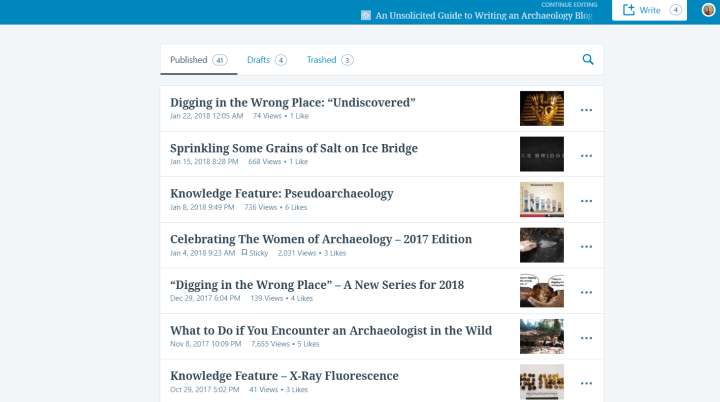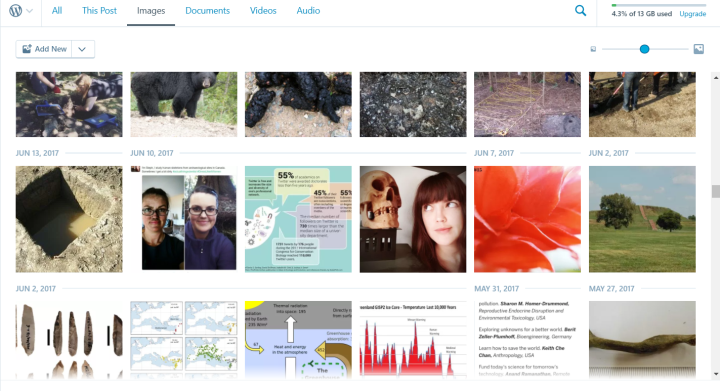
Pic: In my almost two years of blogging I’ve written 41 posts and it’s definitely been a learning experience getting to that point!
There is no doubt that blogs are popular. They have an enormous reach, with approximately 88 million posts being published and around 409 million people reading blog posts every month (these stats are specific to WordPress, which is one of, if not the most popular blog-hosting service) Blogs are everywhere, sometimes hosted by independent researchers focused on specific topics (e.g. The Spade and the Grave, Animal Archaeology, my blog that you’re reading right now) and other times as a part of larger news, magazine, and academic sites with a broader range of topics (i.e. The Guardian, Forbes, Scientific American). Blogs can be written for many different reasons – sharing your research with those within your field, sharing with those outside of the field, building your own reputation and getting your name out there. Your audience will also be just as varied, from experienced researchers to the curious public to students just starting out and holding an interest in your blog’s topic. Whatever the reason for writing or reading a blog, blogs are great sources of information and full of wonderful participatory experiences. And it’s not just me who feels that way!
If you’re reading this blog post than I’m willing to bet you want to give blogging a try. This very unsolicited guide is for you, the writer who wants give blogging a shot but doesn’t know where to start. Or perhaps you’re a student who has a class assignment to write a blog post (which I think is an awesome alternative to a traditional research paper or poster, check out April Beisaw’s class blog for an example). This guide is also for you. This guide is from the perspective of writing about archaeology and is specific to writing individual posts (advice on hosting your own blog deserves a post all on its own). Disclaimer: this guide is entirely based off my own experiences of writing and reading blogs. So, without further ado, my advice to you:
Make sure permissions are in place. This is the most important point I want to make. You must make sure you have all the proper permissions for your content. Are you planning on using photos that aren’t your own? Get permission from the photographer and credit them in your post (even if it’s a photo freely available on the internet or from a publication, give credit). Are there other people in those photos? Make sure you have their permission to include their image. Do you have permission from descendant communities/collaborators/colleagues to publish the written and visual content of your post?

Write a post about a topic you’re interested in. I feel like this is obvious, but I wanted to mention it nonetheless. Pick a topic you have an interest in and use your post as an opportunity to explore it. If you’re a student, try turning one of your class papers into a post (I’ve done that twice – my wolverine post and my Ragnarök post were both inspired by papers I’ve written as an undergrad and grad student).
Think about what why you want to publish it. I would start with looking into whether or not your topic has been blogged about before. If it has, think about why you want to write another post about it. What will make your post different? Will your post compliment the other? Dispute it? Add new information? Do you want your post to be a reference for others? Is this an opinion piece? Thinking about the “why” will help you find your voice and writing style, and will likely vary per post (if you write multiple posts).
Think about your audience. This could fall under “think about why you want to publish”, but it’s important to bring attention to it. Who do you want your audience to be? Readers from within your field, readers from outside the field, or both? They don’t need to be mutually exclusive. My personal rule is that I try to write for those from outside of the field. If I use too much jargon than only a small group of people (archaeologists) can understand me. If I de-jargonize myself, than a much larger group of people (archaeologists, new archaeology students, non-archaeologists) can understand me. If you’re having trouble with jargon, try this handy de-jargonizer.
Figure out where you want to publish your blog post. If you’re writing a blog post for a class assignment your prof will have the website ready for you. But if you’re interested in testing out blogging independent of a class assignment, you’ll likely find yourself unsure of where to go. You’ll want to prepare a “pitch” for starters. Decide on what you want to write about, and from there look for an appropriate site to approach. Keep your eyes open for websites looking for writers (i.e. Women in Archaeology recently mentioned they were looking for contributors and Mx. Moireabh is looking for submissions to their blog on the value of undergrad friendships). When you approach a site you want to pitch your post to, make sure you have a small paragraph written describing a) what you would like to write about, and b) how it would fit in well with their website. Also, if you’re present on social media, don’t be afraid to talk about your interest in writing a blog post – you never know who will see it and invite you to contribute to their blog!
Plan a goal for the length of your post. To be honest, I have yet to find any agreement on a good post length. There has been some study of it, which I flexibly try to adhere to. Any longer than seven minutes to read and your audience will start skimming and not fully reading, but everyone’s reading speed varies so I wouldn’t set this rule in stone. You want your post to be long enough to share the information while short enough to not lose attention. One site found that when a blog post is around 1600 words it’s read thoroughly. But longer posts tended to be shared more. If you’re writing for a class assignment or for a specific website, they’ll likely have the guidelines set out for you. If not, my own personal rule is aim for around 700-900 words for a shorter post, 1200-1500 words for a longer post (with a lot of flexibility). This point in my post is 1060 words.

Do your research. You want your post to be accurate and well-informed. Just like any research paper, you want to make sure you’ve done the proper research to be able to confidently speak about the topic. You want the references to support what you’re saying and what point you’re trying to get across. And if it’s a side-topic you’re interested in pursuing, you’ll want the additional knowledge anyways!
Include your references. Hyperlinks to websites or articles you’re referencing are awesome, but if you don’t have a hyperlink make sure you include the references at the bottom of your post. You want your audience to see that you’ve done your research and trust you know what you’re saying.

Images are great. Images are a fantastic way to break up the text and provide examples for what you’re trying to say. As I’ve already mentioned, make sure you have proper permissions and give proper credit for images. Include captions describing your images. Also, consider the sensitivity of your images and the effects they may have on your readers, even if you have permission to include them (I call it “Ian Malcoming”).
Edit, then edit again. Editing is your friend. It helps get rid of embarrassing typos and it helps you avoid awkward, difficult to read sentences. It also helps you shorten your posts. If you’re a wordy person like me, editing helps prevent a long, rambling post full of repeating statements.
Know that writing a blog post can take a while. And there’s nothing wrong with that! It takes time to gather the research and write it out. Editing takes time. Finding the images to go along with it takes time. Finding your voice and writing style takes time. If I’m lucky I can get a post written in a day, if I have no interruptions. Take your time and make sure you’re happy with the finished product (but embrace the never-perfect attitude – there will always be room for improvement and that’s completely ok! Growth comes from recognizing where and how you could improve).
There you have it. An unsolicited guide on writing an archaeology blog post (though to be honest this seems to be fairly general and applicable to a lot of fiends). If you have any questions about anything, don’t hesitate to send them my way! Also, I’m totally open to pitches, from first-timers and those who have written posts before. If it’s your first time, I’d be really happy to work together on getting your post published!
Good luck with your venture into the wonderful world of blogging!
